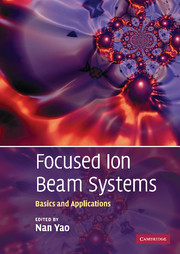Book contents
- Frontmatter
- Contents
- List of contributors
- Preface
- 1 Introduction to the focused ion beam system
- 2 Interaction of ions with matter
- 3 Gas assisted ion beam etching and deposition
- 4 Imaging using electrons and ion beams
- 5 Characterization methods using FIB/SEM DualBeam instrumentation
- 6 High-density FIB-SEM 3D nanotomography: with applications of real-time imaging during FIB milling
- 7 Fabrication of nanoscale structures using ion beams
- 8 Preparation for physico-chemical analysis
- 9 In-situ sample manipulation and imaging
- 10 Micro-machining and mask repair
- 11 Three-dimensional visualization of nanostructured materials using focused ion beam tomography
- 12 Ion beam implantation of surface layers
- 13 Applications for biological materials
- 14 Focused ion beam systems as a multifunctional tool for nanotechnology
- Index
- References
13 - Applications for biological materials
Published online by Cambridge University Press: 12 January 2010
- Frontmatter
- Contents
- List of contributors
- Preface
- 1 Introduction to the focused ion beam system
- 2 Interaction of ions with matter
- 3 Gas assisted ion beam etching and deposition
- 4 Imaging using electrons and ion beams
- 5 Characterization methods using FIB/SEM DualBeam instrumentation
- 6 High-density FIB-SEM 3D nanotomography: with applications of real-time imaging during FIB milling
- 7 Fabrication of nanoscale structures using ion beams
- 8 Preparation for physico-chemical analysis
- 9 In-situ sample manipulation and imaging
- 10 Micro-machining and mask repair
- 11 Three-dimensional visualization of nanostructured materials using focused ion beam tomography
- 12 Ion beam implantation of surface layers
- 13 Applications for biological materials
- 14 Focused ion beam systems as a multifunctional tool for nanotechnology
- Index
- References
Summary
Introduction
Traditional imaging of biological samples has been limited to the use of light microscopes, scanning electron microscopes (SEM), transmission electron microscopes (TEM), and atomic force microscopes (AFM). The information provided by these methods is limited, however, lacking the ability to fully characterize three-dimensional morphology and ultrastructure. Although SEM allows for an analysis of surface morphology, in order, however to study subsurface features complex sectioning must be performed outside of the sample chamber. TEM provides ultra-high resolution, but is unable to offer direct study of three-dimensional morphology. In an opposite manner, AFM provides high resolution in three dimensions, but is unable to reveal information concerning underlying ultrastructure. To overcome these shortcomings, researchers have turned to the focused ion beam (FIB). Traditional use of the FIB has been centered on specimen preparation as well as specimen analysis in the field of semiconductors and microcircuits. Capabilities of the focused ion beam/scanning electron microscope (FIB/SEM) system such as micro-sectioning and in-situ imaging provide an efficient method for failure analysis and repair of defective circuits. Furthermore, gas assisted etching of surface layers can reveal underlying circuitry in localized areas. Development of new techniques for the study of materials by FIB analysis is occurring at a greater frequency as ion beams gain in technical significance.
Despite the well-established use of FIB in the semiconductor field, application of FIB to the study of biological samples remains relatively uncommon [1–10]. Nonetheless, traditional techniques for analysis of traditional hard samples are also applicable to biological samples.
- Type
- Chapter
- Information
- Focused Ion Beam SystemsBasics and Applications, pp. 337 - 354Publisher: Cambridge University PressPrint publication year: 2007
References
- 1
- Cited by



